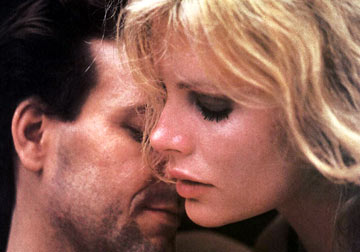After Nine and a Half Weeks came out in 1986, there were several sequels or, more appropriately, attempts at sequels. Here they are:
Attempted Sequel: Four Days in February. In 1989, I read in an obscure movie-theater-industry trade journal that there was a sequel to Nine and a Half Weeks in early pre-production titled Four Days in February. I believe that Mickey Rourke was scheduled to reprise his role as John in the film and Roman Polanski was to direct, but this particular sequel was never made. In the years since then, I have only read one other mention of this never-made sequel.[1]
Non-Sequel: Wild Orchid. Then in 1990, Mickey Rourke starred in Wild Orchid, which is not a sequel to Nine and a Half Weeks. Wild Orchid could be considered the bastard cousin of Nine and Half Weeks I suppose, but that’s about it. Almost no one from Nine and a Half Weeks was involved in Wild Orchid except for Mickey Rourke and Zalman King, and it shows. Wild Orchid is miles away from Nine and Half Weeks in many areas. Whereas Nine and a Half Weeks has (relative) emotional depth, tasteful production design, exquisite cinematography, and beautifully layered music; Wild Orchid has almost none of that. It’s an unintentional parody of Nine and a Half Weeks. It’s an embarrasment to all involved, and a guilty pleasure that I like to watch only within a “so bad, it’s good” framework.
Sequel No. 1: Another 9 1/2 Weeks. Then in 1997, Mickey Rourke starred in Another 9 1/2 Weeks, which is also known as Love in Paris and by a couple of other slight title variations. This sequel to Nine and a Half Weeks should have never been made, period. The thematic depth and aesthetics of Nine and a Half Weeks and Another 9 1/2 Weeks are so radically different that it is almost impossible to think of them as being related. Another 9 1/2 Weeks is pretentious and shallow; it’s a shell of its predecessor. This sequel is of particular interest because it marks the complete, grotesque transformation of Mickey Rourke. When comparing Nine and a Half Weeks to Another 9 1/2 Weeks, one can see how tragic Mickey Rourke’s life and career have become. By the time of Another 9 1/2 Weeks, he has had massive amounts of bad plastic surgery that has altered his face from something uniquely handsome to something grotesquely distorted; his physique has gone from naturally lean and muscular to something resembling a ridiculously inflated superhero, which looks like the result of heavy steroid use; his velvet voice for which he was infamous has transformed into something gruff and nasally, which I can only surmise is from years of heavy cigarette smoking but even more so from the residual effects of capped teeth, plastic surgery, and steroid use; his poetic depth has slid into careless, bored, artless cynicism; and his general artistic choices have gone from genuine, authentic, thoughtful films to commercial pieces of crap. The odd difference between Nine and a Half Weeks and Another 9 1/2 Weeks seems to be matched only by the bizarre transformation of Mickey Rourke from a handsome, intense, poetic actor from the Actor’s Studio to an almost unrecognizable shell of his former self.
Sequel No. 2: The First 9 1/2 Weeks. Then in 1998, The First 9 1/2 Weeks was produced, which appears to be a straight-to-video production involving absolutely no one from Nine and Half Weeks. I have never watched this movie, but I can make an educated guess that the only connection this film has to Nine and Half Weeks is the title. This “sequel,” or “prequel” apparently, appears to be cinematic junk (even if it does involve once-brilliant actors Malcolm McDowell and Frederic Forrest).[3]
Justin Baker
End Notes
[1] Roman Polanski may have channeled his interest in this type of subject matter into his film Bitter Moon [1992], which is also about a sadomasochistic relationship. The sadomasochistic relationship in that film becomes an instance of female dominance over a man, which eventually slides from sexual fantasy into a truly painful reality. It could be inferred from the reversed role of dominance and submission in Bitter Moon as well as the subsequent role reversal in Another Nine and 1/2 Weeks that Four Days in February was to be storyline in which John and Elizabeth switch roles wherein Elizabeth becomes the dominant figure and John becomes the submissive. Polanski channeled his interest in this subject matter yet again when he directed the film Venus in Fur [2013] about sadomasochistic role reversals between a stage actress and director, a film that features Emmanuelle Seigner as the female dominant in a role that was very similar to her role as the female dominant in Bitter Moon. The film Venus in Fur was based on a 2010 off-Broadway play that itself was inspired by the 1870 novel Venus in Furs by Leopold von Sacher-Masoch. The novel Venus in Furs explores a man’s desire to become a woman’s slave in both a sexual and emotional context. The contemporary term masochism is actually derived from Sacher-Masoch’s name whereas the term sadism is derived from the better known writer of sadistic relationships, the Marquis de Sade.
[2] Wild Orchid was directed by Zalman King. Nine and a Half Weeks was produced by Zalman King but directed by the much more talented and complex British director Adrian Lyne who has directed other films of note that explore the dynamics of unconventional and oftentimes explosive or corrosive sexual relationships such as Fatal Attraction [1987], Indecent Proposal [1993], Lolita [1997], and Unfaithful [2002].
[3] This film stars Paul Mercurio, who was the lead in another awful, laughable mainstream S&M film titled Exit to Eden [1994].
